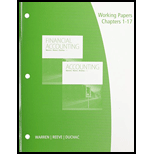
Working Papers, Chapters 1-17 for Warren/Reeve/Duchac's Accounting, 26th and Financial Accounting, 14th
26th Edition
ISBN: 9781305392373
Author: Carl Warren, Jim Reeve, Jonathan Duchac
Publisher: Cengage Learning
expand_more
expand_more
format_list_bulleted
Question
Chapter 25, Problem 25.6APE
To determine
Differential Analysis: Differential analysis refers to the analysis of differential revenue that could be gained or differential cost that could be incurred from the available alternative options of business.
To Prepare: The differential analysis to decide whether to reject or accept the special order.
Expert Solution & Answer
Want to see the full answer?
Check out a sample textbook solution
Students have asked these similar questions
Solve this cogs problem..
Help this answer?
Bistro Brands had the following information:
Total market value of the company's stock: $780
million
Total market value of the company's debt: $220
million
What is the weighted average of the company's debt?
A. 22.00%
B. 28.20%
C. 35.80%
D. 78.00%
E. 90.00%
Chapter 25 Solutions
Working Papers, Chapters 1-17 for Warren/Reeve/Duchac's Accounting, 26th and Financial Accounting, 14th
Ch. 25 - Explain the meaning of (a) differential revenue,...Ch. 25 - A company could sell a building for 250,000 or...Ch. 25 - A chemical company has commodity-grade and...Ch. 25 - A company accepts incremental business at a...Ch. 25 - A company fabricates a component at a cost of...Ch. 25 - Prob. 6DQCh. 25 - In the long run, the normal selling price must be...Ch. 25 - Although the cost-plus approach to product pricing...Ch. 25 - How does the target cost concept differ from...Ch. 25 - Prob. 10DQ
Ch. 25 - Under what conditions might a company use...Ch. 25 - Prob. 25.1APECh. 25 - Lease or sell Timberlake Company owns equipment...Ch. 25 - Prob. 25.2APECh. 25 - Discontinue a segment Product B has revenue of...Ch. 25 - Prob. 25.3APECh. 25 - Make or buy A company manufactures various sized...Ch. 25 - Prob. 25.4APECh. 25 - Replace equipment A machine with a book value of...Ch. 25 - Prob. 25.5APECh. 25 - Process or sell Product D is produced for 24 per...Ch. 25 - Prob. 25.6APECh. 25 - Prob. 25.6BPECh. 25 - Product cost markup percentage Magna Lighting Inc....Ch. 25 - Product cost markup percentage Green Thumb Garden...Ch. 25 - Bottleneck profit Product A has a unit...Ch. 25 - Prob. 25.8BPECh. 25 - Activity-based costing Mainline Marine Company has...Ch. 25 - Activity-based costing Casual Cuts Inc. has total...Ch. 25 - Differential analysis for a lease or sell decision...Ch. 25 - Prob. 25.2EXCh. 25 - Differential analysis for a discontinued product A...Ch. 25 - Differential analysis for a discontinued product...Ch. 25 - Segment analysis for a service company Charles...Ch. 25 - Prob. 25.6EXCh. 25 - Make-or -buy decision Jupiter Computer Company has...Ch. 25 - Make-or-buy decision for a service company The...Ch. 25 - Machine replacement decision A company is...Ch. 25 - Differential analysis for machine replacement Kim...Ch. 25 - Prob. 25.11EXCh. 25 - Prob. 25.12EXCh. 25 - Decision on accepting additional business...Ch. 25 - Accepting business at a special price Portable...Ch. 25 - Prob. 25.15EXCh. 25 - Accepting business at a special price for a...Ch. 25 - Product cost concept of product pricing La Femme...Ch. 25 - Product cost concept of product costing Smart...Ch. 25 - Target costing Toyota Motor Corporation uses...Ch. 25 - Target costing Instant Image Inc. manufactures...Ch. 25 - Product decisions under bottlenecked operations...Ch. 25 - Product decisions under bottlenecked operations...Ch. 25 - Activity-based costing CardioTrainer Equipment...Ch. 25 - Activity-based costing Zeus Industries...Ch. 25 - Activity rates and product costs using...Ch. 25 - Total cost concept of product pricing Based on the...Ch. 25 - Variable cost concept of product pricing Based on...Ch. 25 - Differential analysis involving opportunity costs...Ch. 25 - Differential analysis for machine replacement...Ch. 25 - Differential analysis for sales promotion proposal...Ch. 25 - Prob. 25.4APRCh. 25 - Prob. 25.5APRCh. 25 - Prob. 25.6APRCh. 25 - Activity-based costing Pure Cane Sugar Company...Ch. 25 - Prob. 25.1BPRCh. 25 - Differential analysis for machine replacement...Ch. 25 - Differential analysis for sales promotion proposal...Ch. 25 - Differential analysis for further processing The...Ch. 25 - Prob. 25.5BPRCh. 25 - Product pricing and profit analysis with...Ch. 25 - Activity-based costing Southeastern Paper Company...Ch. 25 - Ethics in Action Aaron McKinney is a cost...Ch. 25 - Decision on accepting additional business A...Ch. 25 - Accept business at a special price for a service...Ch. 25 - Communication The following conversation took...Ch. 25 - Identifying product cost distortion Peachtree...
Knowledge Booster
Similar questions
- A warehouse fire on September 25 destroyed all inventory. The company retrieved the following information: Beginning Inventory (Jan. 1): $220,000 • Net Purchases (Jan. 1 - Sept. 25): $1,750,000 • Net Sales (Jan. 1 - Sept. 25): $3,000,000 • Estimated Gross Profit Rate: 38%arrow_forwardlabor price variance?arrow_forward??!arrow_forward
- A company has the following financial data: Operating income: $400,000 • Average operating assets: $2,000,000 • Minimum required rate of return: 12% What is the company's residual income?arrow_forwardHi expert please give me answer general accounting questionarrow_forwardHow many times per year does the company reorder of this financial accounting question?arrow_forward
arrow_back_ios
SEE MORE QUESTIONS
arrow_forward_ios
Recommended textbooks for you
 Managerial AccountingAccountingISBN:9781337912020Author:Carl Warren, Ph.d. Cma William B. TaylerPublisher:South-Western College Pub
Managerial AccountingAccountingISBN:9781337912020Author:Carl Warren, Ph.d. Cma William B. TaylerPublisher:South-Western College Pub

Managerial Accounting
Accounting
ISBN:9781337912020
Author:Carl Warren, Ph.d. Cma William B. Tayler
Publisher:South-Western College Pub